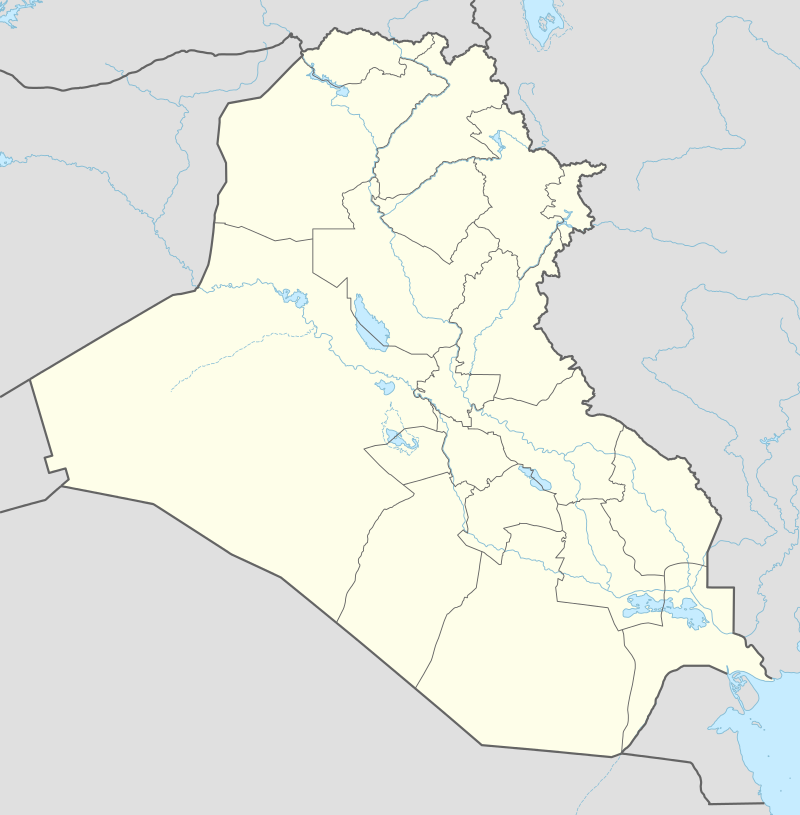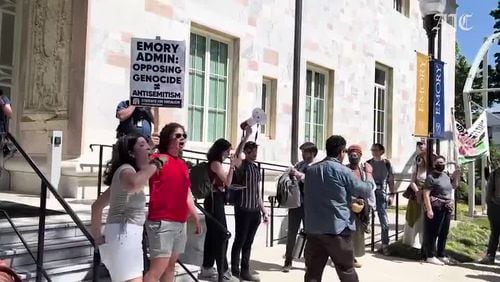President Donald Trump announced new economic sanctions against Iran on Wednesday, as he addressed the nation following a series of Iranian ballistic missile attacks.
At the same time, Trump said “Iran is standing down” following the attacks, which were launched in retaliation for a U.S. drone strike last week that killed a top Revolutionary Guard commander. The president said no American or Iraqi lives were lost in the attacks, and that he will ask NATO to become more involved in the Middle East peace process.
On Wednesday afternoon, two rockets landed in Baghdad’s Green Zone, but no casualties were reported, according to Reuters.
Joint Chiefs of Staff Chairman Mark Milley and Secretary of Defense Mark Esper told reporters Wednesday afternoon they believe Iran was targeting U.S. lives at the Ain al-Asad air base. Early warning saved those lives, according to McClatchy reporter Tara Copp.
Iran's attack was the nation's most direct assault on America since the 1979 seizing of the U.S. Embassy in Tehran, and Iranian state TV said it was in revenge for the U.S. killing of Revolutionary Guard Gen. Qassem Soleimani, whose death last week in an American drone strike near Baghdad prompted angry calls to avenge his slaying.
On Wednesday, Trump said Soleimani was responsible for “some of the absolutely worst atrocities” against civilians. Trump also said Soleimani was planning attacks against more American targets, but “we stopped him.”
"By removing Soleimani, we are sending a powerful message to terrorists,” Trump said. “As we continue to evaluate options in response to Iranian aggression the U.S. will immediately impose additional punishing sanctions on the Iranian regime."
A presenter on Iranian state television later claimed, without offering evidence, that the strikes killed “at least 80 terrorist U.S. soldiers” and also damaged helicopters, drones and other equipment at the Ain al-Asad air base.
»PREVIOUS COVERAGE: Push to oust US troops from Iraq a risky undertaking
The strikes, which came as Iran buried Soleimani, raised fears that the two longtime foes were closer to war. But there were some indications that there would not be further retaliation on either side, at least in the short term.
Watch the president’s remarks below.
'All is well!' President Donald Trump tweeted shortly after the missile attacks, adding, 'So far, so good' regarding casualties. Moments earlier, Iran’s foreign minister tweeted that Tehran had taken “& concluded proportionate measures in self-defense,” adding that Tehran did “not seek escalation" but would defend itself against further aggression.
On Wednesday, Trump said "the U.S. is ready to embrace peace with all who seek it," and cited American independence from Middle East-produced oil.
“We are independent and do not need Middle East oil,” Trump said.
In Tehran, Supreme Leader Ayatollah Ali Khamenei called the missile strike on the U.S. bases in Iraq a “slap in the face” of the Americans, adding that military retaliation is not sufficient. “The corrupt presence of the U.S. in the region should come to (an) end,” he said.
The killing of Soleimani — a national hero to many in Iran — and strikes by Tehran came as tensions have been rising steadily across the Mideast after Trump’s decision to unilaterally withdraw America from Tehran’s nuclear deal with world powers.
They also marked the first time in recent years that Washington and Tehran have attacked each other directly rather than through proxies in the region. It raised the chances of open conflict erupting between the two enemies, who have been at odds since Iran's 1979 Islamic Revolution and the subsequent U.S. Embassy takeover and hostage crisis.
»MORE: 40 years ago, Iranian hostage crisis dooms Jimmy Carter's presidency
Adding to the chaos and overall jitters, a Ukrainian airplane with at least 170 people crashed after takeoff just outside Tehran on Wednesday morning, killing all on board, state TV reported. The plane had taken off from Imam Khomeini International Airport and mechanical issues were suspected, the report said.
Iran initially announced only one missile strike, but U.S. officials confirmed both. U.S. defense officials were at the White House, likely to discuss options with Trump, who launched the attack on Soleimani while facing an upcoming impeachment trial in the Senate.
Iran’s Revolutionary Guard warned the U.S. and its regional allies against retaliating over the missile attack on the Ain al-Asad air base in Iraq’s western Anbar province. The Guard issued the warning via a statement carried by Iran’s state-run IRNA news agency.
“We are warning all American allies, who gave their bases to its terrorist army, that any territory that is the starting point of aggressive acts against Iran will be targeted,” the Guard said. It also threatened Israel.
After the strikes, a former Iranian nuclear negotiator posted a picture of the Islamic Republic’s flag on Twitter, appearing to mimic Trump who posted an American flag following the killing of Soleimani and others Friday.
Ain al-Asad air base was first used by American forces after the 2003 U.S.-led invasion that toppled dictator Saddam Hussein and later saw American troops stationed there amid the fight against the Islamic State group in Iraq and Syria. It houses about 1,500 U.S. and coalition forces. The U.S. also acknowledged another missile attack targeting a base in Irbil in Iraq’s semi-autonomous Kurdish region.
The Iranians fired 15 missiles, two U.S. officials said. Ten hit Ain al-Asad and one the base in Irbil. Four failed, said the officials, who were not authorized to speak publicly about a military operation.
Two Iraqi security officials said at least one of the missiles appeared to have struck a plane at the Ain al-Asad base, igniting a fire. There were no immediate reports of casualties from the attacks, according to the officials, who spoke on condition of anonymity as they had no permission to talk to journalists.
About 70 Norwegian troops also were on the air base but no injuries were reported, Brynjar Stordal, a spokesperson for the Norwegian Armed Forces, told The Associated Press.
Credit: AJC
Trump visited the sprawling Ain al-Asad air base, about 60 miles west of Baghdad, in December 2018, making his first presidential visit to troops in the region. Vice President Mike Pence also has visited the base.
“As we evaluate the situation and our response, we will take all necessary measures to protect and defend U.S. personnel, partners and allies in the region,” said Jonathan Hoffman, an assistant to the U.S. defense secretary.
Wednesday's missile strikes happened a few hours after crowds in Iran mourned Soleimani at his funeral. It also came as the U.S. continued to reinforce its own positions in the region and warned of an unspecified threat to shipping from Iran in the Mideast waterways, crucial routes for global energy supplies. U.S. embassies and consulates from Asia to Africa and Europe issued security alerts for Americans. The FAA also warned of a "potential for miscalculation or mis-identification" for civilian aircraft in the Persian Gulf amid in an emergency flight restriction.
A stampede broke out Tuesday at Soleimani's funeral, and at least 56 people were killed and more than 200 were injured as thousands thronged the procession, Iranian news reports said. Shortly after Wednesday's missile attack, Soleimani's shroud-wrapped remains were lowered into the ground as mourners wailed at the gravesite.
»MORE: 56 dead after stampede erupts at funeral for Iranian general killed by US
Tuesday’s deadly stampede took place in Soleimani’s hometown of Kerman as his coffin was being borne through the city in southeastern Iran, said Pirhossein Koulivand, head of Iran’s emergency medical services.
There was no information about what set off the crush in the packed streets, and online videos showed only its aftermath: people lying apparently lifeless, their faces covered by clothing, emergency crews performing CPR on the fallen, and onlookers wailing and crying out to God.
»MORE: Iran vows revenge after U.S. airstrike kills top general
Hossein Salami, Soleimani’s successor as leader of the Revolutionary Guard, earlier addressed a crowd of supporters in Kernan and vowed to avenge Soleimani.
“We tell our enemies that we will retaliate, but if they take another action we will set ablaze the places that they like and are passionate about,” Salami said.
Soleimani was laid to rest between the graves of Enayatollah Talebizadeh and Mohammad Hossein Yousef Elahi, two former Guard comrades killed in Iran’s 1980s war with Iraq. They died in Operation Dawn 8, in which Soleimani also took part. It was a 1986 amphibious assault that cut Iraq off from the Persian Gulf and led to the end of the war that killed 1 million.
The funeral processions in major cities over three days have been an unprecedented honor for Soleimani, seen by Iranians as a national hero for his work leading the Guard’s expeditionary Quds Force.
The U.S. blames him for killing U.S. troops in Iraq and accused him of plotting new attacks just before he was killed. Soleimani also led forces supporting Syrian President Bashar Assad in that country’s civil war. Russian President Vladimir Putin met with Assad in Syria on Tuesday amid the tensions between Washington and Tehran.
As of 9:25 p.m. ET Tuesday, U.S. military officials told a Washington Post reporter they did not have clear information whether there were American casualties in the strikes.
If the U.S. retaliates, Lebanon Hezbollah planned to target Israel with its missiles, according to the Tasnim news agency.
A BBC correspondent reported that Iran’s ambassador to the United Nations wrote a letter to UN Secretary General António Guterres declaring that his country does not seek war.
According to a report by the country’s state-run news outlet ISNA, the IRGC Air Force launched the missiles, referring to the mission as “Operation Martyr Soleimani.”
“This morning, courageous fighters of the IRGC’s Air Force launched a successful operation called Operation Martyr Soleimani, with the code 'Oh Zahra' by firing tens of ground-to-ground missiles at the base of the terrorist and invasive U.S. forces,” the publication reported.
At the attack on the Al-Asad Air Base, there were reportedly at least nine rockets that hit Tuesday, according to The Jerusalem Post. The Iranian Revolutionary Guards Corp confirmed to the Post that it issued the attack as its initial effort of retaliation for the U.S.' targeted killing of Quds Force commander Soleimani.
The Associated Press contributed to this report.







